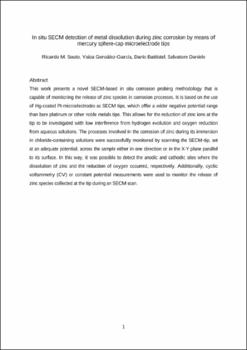In situ scanning electrochemical microscopy (SECM) detection of metal dissolution during zinc corrosion by means of mercury sphere-cap microelectrode tips.
Fecha
2012Resumen
This work presents a novel SECM-based in situ corrosion probing methodology that is capable of monitoring the release of zinc species in corrosion processes. It is based on the use of Hg-coated Pt-microelectrodes as SECM tips, which offer a wider negative potential range than bare platinum or other noble metals tips. This allows for the reduction of zinc ions at the tip to be investigated with low interference from hydrogen evolution and oxygen reduction from aqueous solutions. The processes involved in the corrosion of zinc during its immersion in chloride-containing solutions were successfully monitored by scanning the SECM-tip, set at an adequate potential, across the sample either in one direction or in the X-Y plane parallel to its surface. In this way, it was possible to detect the anodic and cathodic sites where the dissolution of zinc and the reduction of oxygen occurred, respectively. Additionally, cyclic voltammetry (CV) or constant potential measurements were used to monitor the release of zinc species collected at the tip during an SECM scan.






